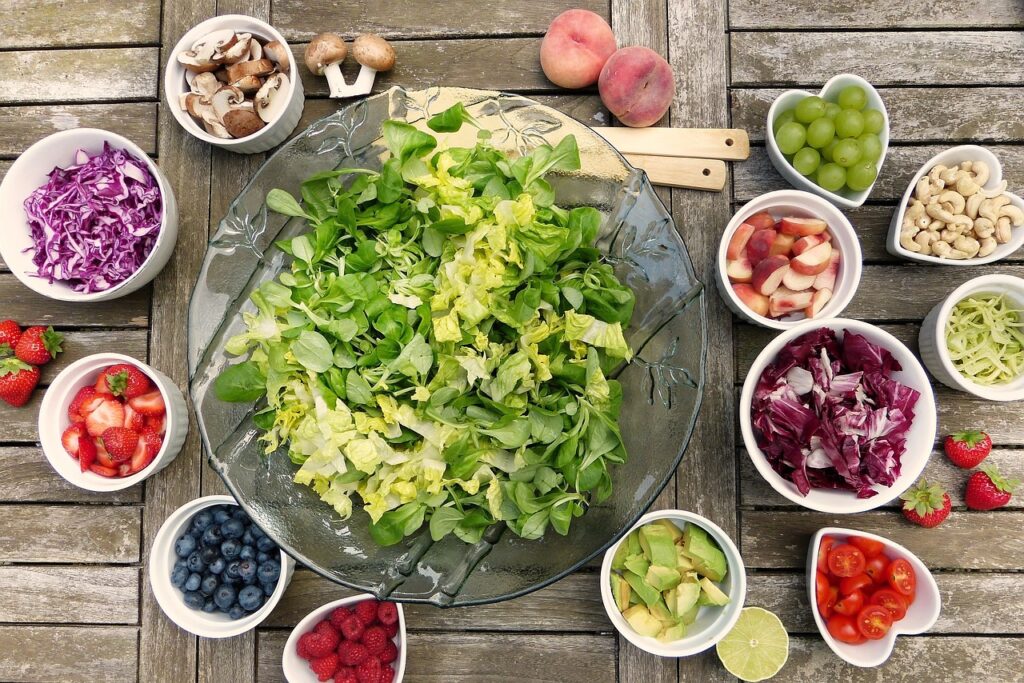
Are you struggling to prepare meals that cater to the specific dietary needs of your elderly family members? If so, look no further than “How Do I Cook For A Family With Elderly Members?” This comprehensive guide is designed to assist you in navigating the challenges of cooking for senior loved ones, providing practical tips and expert advice to ensure you can create nutritious and delicious meals that meet their unique needs. Whether you’re a seasoned chef or a novice in the kitchen, this invaluable resource will empower you to confidently prepare meals that enhance their health and well-being. Say goodbye to mealtime stress and hello to a happier, healthier family!

Choosing Nutritious Ingredients
Consider dietary restrictions and preferences
When cooking for a family with elderly members, it is important to take into consideration any dietary restrictions or preferences they may have. Some individuals may have allergies or intolerances to certain foods, while others may be following a specific diet due to a medical condition. By understanding these restrictions and preferences, you can ensure that the meals you prepare are not only delicious but also safe and suitable for everyone.
Focus on nutrient-dense foods
To meet the nutritional needs of the elderly, it is crucial to focus on incorporating nutrient-dense foods into their meals. Nutrient-dense foods are those that provide a high amount of essential vitamins, minerals, and other important nutrients relative to their calorie content. Some examples of nutrient-dense foods include fruits, vegetables, whole grains, lean proteins, and healthy fats. By including these foods in your recipes, you can help promote overall health and well-being for your elderly family members.
Opt for easy-to-eat foods
It is common for elderly individuals to have difficulty with chewing or swallowing, which can make eating certain foods challenging. To make mealtime more enjoyable and manageable, opt for easy-to-eat foods. This can include cutting ingredients into small, bite-sized pieces to minimize the need for extensive chewing. Additionally, choosing tender cooking methods such as roasting or steaming can help make foods softer and easier to consume. By considering the texture and consistency of the dishes you prepare, you can ensure a pleasant dining experience for your elderly family members.
Preparation Tips for Elderly-friendly Meals
Chop ingredients into small, bite-sized pieces
As mentioned earlier, elderly individuals may have difficulty chewing or swallowing larger food pieces. To accommodate this, it is important to chop ingredients into small, bite-sized pieces. This makes it easier for them to manage and enjoy their meals without discomfort. Whether it’s fruits, vegetables, or proteins, taking the time to cut them into manageable sizes can greatly enhance the dining experience for your elderly family members.
Use tender cooking methods
Cooking methods can greatly impact the texture and tenderness of foods, which is particularly important when catering to elderly individuals. Opting for tender cooking methods such as baking, steaming, or slow cooking can help make foods softer and more easily chewable. This can be especially beneficial for meats and vegetables that may be tougher when cooked using more aggressive methods such as frying or grilling. By using gentle cooking techniques, you can ensure that the meals you prepare are not only nutritious but also enjoyable to eat for your elderly family members.
Add flavor without excess salt or sugar
While it’s important to make meals flavorful and enjoyable, it’s equally important to be mindful of excess salt and sugar intake. Elderly individuals often have specific dietary needs, and excessive amounts of salt or sugar can adversely affect their health. Instead, focus on using herbs, spices, and other flavor-enhancing ingredients to add depth to your dishes. By exploring different flavor profiles and experimenting with seasonings, you can create delicious meals that are low in sodium and sugar, without compromising on taste.
Meal Planning and Portion Control
Plan balanced meals with a variety of nutrients
Meal planning is an essential aspect of cooking for a family with elderly members. By planning balanced meals, you can ensure that your loved ones are receiving a variety of nutrients necessary for their health and well-being. Include a mix of carbohydrates, proteins, and healthy fats in each meal, alongside an abundance of fruits and vegetables. Aim to incorporate foods from all food groups to provide a diverse range of vitamins, minerals, and other essential nutrients. Additionally, consider the specific nutritional requirements of elderly individuals, such as the need for increased vitamin D or calcium, and incorporate foods that address these needs.
Consider smaller, more frequent meals
For elderly individuals, it may be more comfortable to consume smaller, more frequent meals throughout the day instead of three large meals. This can help prevent feelings of fullness and discomfort, as well as aid in digestion. Consider dividing their daily food intake into five or six smaller meals or snacks, spaced out evenly throughout the day. This approach not only allows for better portion control but also makes it easier for elderly individuals to maintain steady energy levels.
Use portion control
When cooking for elderly family members, it is important to practice portion control to avoid overeating and to ensure that they are receiving the appropriate amount of nutrients. Aging bodies may have different caloric requirements, and overeating can lead to weight gain and other health issues. Be conscious of the portion sizes, using measuring cups or scales when necessary. By serving appropriately sized portions, you can help maintain a healthy weight for your elderly loved ones while still providing them with the necessary nutrients.
Safety Precautions in the Kitchen
Minimize hazards and prevent accidents
Safety should always be a top priority when cooking, especially when preparing meals for elderly family members. Take proactive measures to minimize hazards in the kitchen by keeping the cooking area clean and free of clutter. Ensure that walkways are clear, electrical cords are properly managed, and all cooking equipment is in good working condition. Additionally, using non-slip mats or rugs can help reduce the risk of slips and falls. By taking these precautions, you can create a safe environment for meal preparation.
Ensure food safety practices
Food safety is crucial when cooking for any individual, but it is particularly important when preparing meals for elderly family members who may have a weakened immune system. Follow proper food safety practices such as washing hands thoroughly before and after handling food, using separate cutting boards for raw meats and vegetables, and cooking foods at appropriate temperatures to prevent foodborne illnesses. Additionally, be mindful of expiration dates and properly store perishable items. By implementing these food safety practices, you can minimize the risk of foodborne illnesses and ensure the well-being of your elderly loved ones.
Consider texture modification for swallowing difficulties
Elderly individuals who have difficulty swallowing may benefit from modifications in food texture to ensure their safety and enjoyment during meals. This can involve altering the consistency of certain foods, such as pureeing vegetables or blending soups to a smoother texture. Additionally, using thickeners for liquids can help make them easier to swallow. Consult a healthcare professional or dietitian for guidance on texture modifications to ensure that meals are prepared in a way that is suitable for your elderly family members’ specific needs.

Adapting Recipes and Modifying Texture
Adjust recipes for dietary needs and food preferences
When cooking for a family with elderly members, it is important to adapt recipes to accommodate their specific dietary needs and food preferences. Whether it’s adjusting the amount of sugar or salt in a recipe, substituting ingredients to avoid allergens, or modifying the cooking method to cater to their preferences, flexibility is key. Get creative with ingredient substitutions and explore alternative cooking techniques to ensure that the meals you prepare are both nutritious and enjoyable for your elderly family members.
Modify food texture for dental or swallowing issues
Some elderly individuals may face challenges with dental issues or swallowing difficulties, making it necessary to modify food texture accordingly. This can involve softening or pureeing foods to make them easier to chew and swallow. For example, steaming vegetables until they are tender or blending fruits into smoothies can help create meals that are more suitable for their needs. By modifying food texture, you can ensure that your elderly family members can still indulge in flavorful meals that are satisfying and easy to eat.
Consult a dietitian for personalized advice
If you are unsure about the specific dietary needs and modifications required for your elderly family members, it is always recommended to consult a registered dietitian. They can provide personalized advice, taking into consideration any medical conditions, food allergies, or intolerances. A dietitian can help create a meal plan that meets the unique nutritional requirements of your loved ones, ensuring that they are receiving the necessary nutrients while enhancing their overall dining experience.
Addressing Special Dietary Concerns
Accommodate medical conditions like diabetes or high blood pressure
When cooking for a family with elderly members, it is crucial to address any special dietary concerns that may arise due to medical conditions. Conditions such as diabetes or high blood pressure require careful monitoring of sugar and sodium intake. Be mindful of the ingredients used in your recipes and opt for healthier alternatives, such as substituting refined sugar with natural sweeteners like honey or fruits. Additionally, incorporate nutrient-rich foods that can help manage these conditions, such as whole grains, lean proteins, and vegetables. By accommodating these dietary concerns, you can actively contribute to the well-being and management of your elderly family members’ health.
Manage food allergies or intolerances
Food allergies and intolerances can significantly impact a person’s dietary choices and restrictions. If any of your elderly family members have food allergies or intolerances, it is important to diligently manage and accommodate them. Review ingredient labels carefully and ensure that the meals you prepare are free from the allergens in question. If necessary, seek alternative ingredients that can be used as substitutes, without compromising the taste or nutritional value of the dishes. By managing food allergies or intolerances effectively, you can provide safe and enjoyable meals for your elderly loved ones.
Incorporate recommended supplements or medication
In some cases, elderly individuals may require specific supplements or medications to maintain their health and manage certain conditions. It is important to incorporate these recommendations into their diet by considering any dietary restrictions or interactions with food that may exist. Take note of any timing requirements for medications or supplements and consider them when planning meals. By incorporating these prescribed elements into their diet, you can ensure that your elderly family members receive the necessary nutrients and medications to support their overall well-being.

Increase Hydration and Fluid Intake
Offer hydrating foods and drinks
Maintaining proper hydration is vital for the elderly, as they may have a decreased sense of thirst or difficulty managing their fluid intake. One way to encourage hydration is by offering hydrating foods and drinks. Soups, broths, fruits with high water content such as watermelon or oranges, and herbal teas can be excellent choices. These options not only provide essential fluids but also contribute to overall nutrition. By incorporating hydrating foods and drinks into your meal planning, you can support the hydration needs of your elderly family members.
Encourage water intake throughout the day
In addition to offering hydrating foods and drinks, it is important to encourage your elderly family members to consume an adequate amount of water throughout the day. Dehydration can lead to various health issues and can be particularly detrimental to the elderly. Remind them to take sips of water regularly, especially during and in between meals. Consider providing them with water bottles or setting reminders to ensure they are staying hydrated. By actively promoting water intake, you can help maintain their well-being and prevent dehydration-related complications.
Monitor signs of dehydration
Even with the best efforts to encourage hydration, it is crucial to monitor the signs of dehydration in your elderly family members. Some common symptoms of dehydration include dry mouth, dark-colored urine, fatigue, dizziness, and confusion. If you notice any of these signs, it is important to take immediate action. Encourage your loved ones to drink more water, provide hydrating foods and drinks, and consult a healthcare professional if necessary. By staying vigilant and addressing signs of dehydration promptly, you can ensure the optimal health and well-being of your elderly family members.
Easy and Convenient Meal Ideas
Slow cooker or Instant Pot recipes
When juggling various responsibilities, it can be challenging to find time to cook elaborate meals. Utilizing kitchen appliances such as slow cookers or Instant Pots can be a game-changer when cooking for a family with elderly members. These appliances allow you to prepare delicious and nutritious meals with minimal effort and time. Simply assemble the ingredients, set the desired cooking time, and let the appliance do the work. From soups and stews to tender meats and flavorful vegetables, the possibilities are endless. Slow cooker and Instant Pot recipes offer convenience and efficiency, ensuring that you can provide satisfying meals for your elderly family members without sacrificing quality.
One-pot meals or casseroles
One-pot meals and casseroles are not only convenient but also provide a variety of ingredients in a single dish. They often require minimal preparation and can be easily customized to accommodate dietary preferences and restrictions. By combining proteins, vegetables, and grains or pasta in one pot or baking dish, you can create flavorful and nutritious meals that require less clean-up. These meals also have the added benefit of being easily reheatable, making them suitable for leftovers. Whether it’s a hearty beef stew or a comforting pasta bake, one-pot meals and casseroles offer simplicity and efficiency when cooking for a family with elderly members.
Freezer-friendly meals and leftovers
Cooking larger quantities of food and freezing portions can be a time-saving strategy when cooking for a family with elderly members. Freezer-friendly meals can be prepared in advance and stored in individual or family-sized portions for future consumption. This not only saves time on busy days but also ensures that your elderly family members have access to nutritious meals whenever they need them. Leftovers from previous meals can also be stored in the freezer for later use. By utilizing this approach, you can maintain a consistent supply of healthy and convenient meals for your loved ones, even during hectic times.
Getting the Family Involved
Share responsibilities and divide tasks
Cooking for a family with elderly members can be a collaborative effort that involves the entire family. Encourage family members to share responsibilities and divide tasks when it comes to meal preparation. This not only lightens the load but also promotes teamwork and a sense of togetherness. Assigning specific roles such as grocery shopping, chopping ingredients, or cooking can make the process more efficient and enjoyable. By involving the whole family, you can create a positive and engaging environment that fosters a shared responsibility in taking care of your elderly loved ones.
Encourage participation and engagement
When cooking for elderly family members, it is essential to encourage their active participation and engagement during meal preparation. This can be as simple as allowing them to choose a recipe or providing input on meal ideas. Engage them in conversations about food and family traditions, encouraging them to share their memories and experiences. By involving them in the decision-making process and valuing their input, you can foster a sense of inclusion and empower them to actively participate in family meals.
Promote quality time during meal preparation
Meal preparation can be an excellent opportunity to bond and spend quality time with your elderly family members. Rather than viewing it as a chore, consider it as an enjoyable activity that brings everyone together. Use this time to connect with each other, share stories, or simply catch up on each other’s lives. Encourage laughter, play their favorite songs, or engage in light-hearted conversation. By promoting quality time during meal preparation, you can create memorable experiences and nourish not only their bodies but also their souls.
Considerations for Dining Experience
Create a comfortable and accessible eating environment
When planning meals for elderly family members, it is important to create a comfortable and accessible eating environment. Consider their physical limitations and make sure the dining area is well-lit, free from obstructions, and easy to navigate. Use chairs with adequate back support and cushioning to ensure they can sit comfortably throughout the meal. Additionally, make sure the table height is appropriate, allowing them to eat without straining or experiencing discomfort. By prioritizing comfort and accessibility, you can enhance the dining experience for your elderly loved ones.
Encourage social interaction during meals
Mealtimes should not only be about nourishing the body but also nurturing social connections. Encourage social interaction during meals by creating a warm and inviting environment. Engage in conversation, ask open-ended questions, and actively listen to your elderly family members’ stories and experiences. Encourage them to share their thoughts, opinions, and memories. Additionally, consider inviting other family members or friends to join in on meals, creating a sense of community and companionship. By fostering meaningful social interactions, you can enhance the overall dining experience and promote overall well-being.
Adapt to specific dietary needs in a group setting
In a group setting where various dietary needs and preferences are present, it is important to adapt and accommodate everyone’s specific requirements. Whether it’s dealing with allergies, diabetes, or other medical conditions, ensure that the meals you prepare cater to everyone’s needs. Offer a variety of dishes that are suitable for different dietary restrictions and preferences. Clearly label any allergens or special ingredients to ensure everyone is aware and can make informed choices. By being flexible and considerate of everyone’s dietary needs, you can create a welcoming and inclusive dining experience for your elderly family members.
In conclusion, cooking for a family with elderly members requires careful consideration of dietary restrictions and preferences, as well as a focus on nutrient-dense ingredients. Preparing meals in ways that are easy to eat and adapting recipes to accommodate dental or swallowing issues can enhance the dining experience for elderly individuals. Meal planning, portion control, and kitchen safety precautions are essential aspects to ensure their well-being. Addressing special dietary concerns, increasing hydration, and involving the family in meal preparation can further contribute to their overall health and happiness. By considering factors such as the dining environment and promoting social interaction, you can create a positive and enjoyable experience for your elderly family members. Remember to consult a dietitian for personalized advice and always prioritize their specific needs and preferences when it comes to cooking and meal planning.
